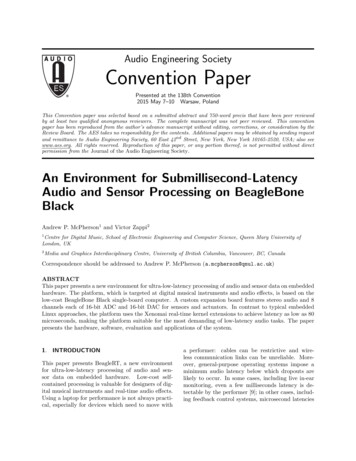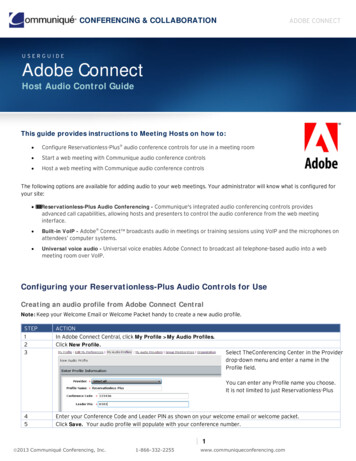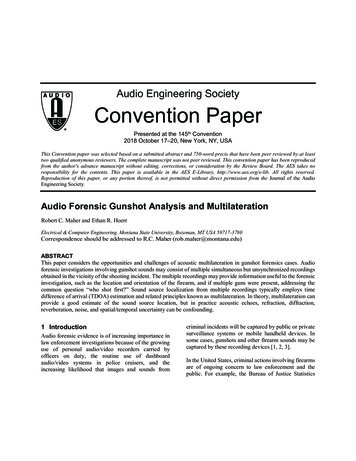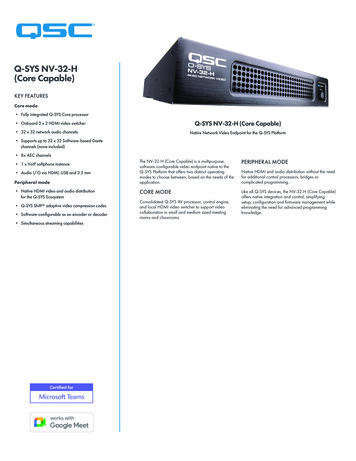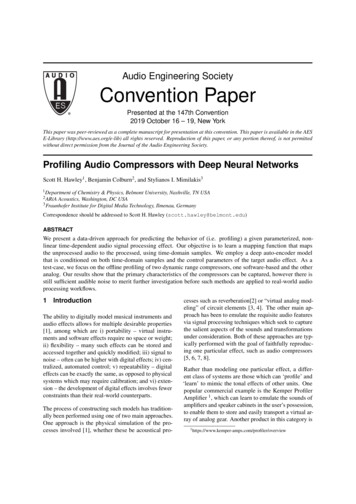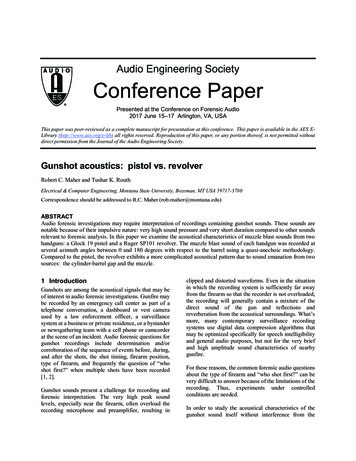
Transcription
Audio Engineering SocietyConference PaperPresented at the Conference on Forensic Audio2017 June 15–17 Arlington, VA, USAThis paper was peer-reviewed as a complete manuscript for presentation at this conference. This paper is available in the AES ELibrary (http://www.aes.org/e-lib) all rights reserved. Reproduction of this paper, or any portion thereof, is not permitted withoutdirect permission from the Journal of the Audio Engineering Society.Gunshot acoustics: pistol vs. revolverRobert C. Maher and Tushar K. RouthElectrical & Computer Engineering, Montana State University, Bozeman, MT USA 59717-3780Correspondence should be addressed to R.C. Maher (rob.maher@montana.edu)ABSTRACTAudio forensic investigations may require interpretation of recordings containing gunshot sounds. These sounds arenotable because of their impulsive nature: very high sound pressure and very short duration compared to other soundsrelevant to forensic analysis. In this paper we examine the acoustical characteristics of muzzle blast sounds from twohandguns: a Glock 19 pistol and a Ruger SP101 revolver. The muzzle blast sound of each handgun was recorded atseveral azimuth angles between 0 and 180 degrees with respect to the barrel using a quasi-anechoic methodology.Compared to the pistol, the revolver exhibits a more complicated acoustical pattern due to sound emanation from twosources: the cylinder-barrel gap and the muzzle.1 IntroductionGunshots are among the acoustical signals that may beof interest in audio forensic investigations. Gunfire maybe recorded by an emergency call center as part of atelephone conversation, a dashboard or vest cameraused by a law enforcement officer, a surveillancesystem at a business or private residence, or a bystanderor newsgathering team with a cell phone or camcorderat the scene of an incident. Audio forensic questions forgunshot recordings include determination and/orcorroboration of the sequence of events before, during,and after the shots, the shot timing, firearm position,type of firearm, and frequently the question of “whoshot first?” when multiple shots have been recorded[1, 2].Gunshot sounds present a challenge for recording andforensic interpretation. The very high peak soundlevels, especially near the firearm, often overload therecording microphone and preamplifier, resulting inclipped and distorted waveforms. Even in the situationin which the recording system is sufficiently far awayfrom the firearm so that the recorder is not overloaded,the recording will generally contain a mixture of thedirect sound of the gun and reflections andreverberation from the acoustical surroundings. What’smore, many contemporary surveillance recordingsystems use digital data compression algorithms thatmay be optimized specifically for speech intelligibilityand general audio purposes, but not for the very briefand high amplitude sound characteristics of nearbygunfire.For these reasons, the common forensic audio questionsabout the type of firearm and “who shot first?” can bevery difficult to answer because of the limitations of therecording. Thus, experiments under controlledconditions are needed.In order to study the acoustical characteristics of thegunshot sound itself without interference from the
Maher and RouthGunshot acoustics: pistol vs. revolverreflections and reverberation of the environment andfrom the distortion and other limitations of therecording system, for research purposes we havedeveloped a quasi-anechoic recording methodology.The procedure involves elevating the firearm and therecording microphones in an open outdoor area so thatthe firearm’s muzzle blast can be recorded in its entiretybefore the first reflection (from the ground) arrives atthe microphone [3, 4].Distinguishing among different firearms based upon thegunshot sound is only possible if there are distinctiveacoustic features the distinguish one shot from another.Our recent research using carefully-controlled gunshotrecordings is starting to reveal the subtleties of thesedetails.handguns are semi-automatic, which means the gun hasa mechanism that automatically ejects a spent shellcasing and positions a new round in the firing chamberafter each pull of the trigger, without a manual cockingmechanism. Each pull of the trigger for a semiautomatic firearm shoots one bullet. 1There are two common types of repeating handguns thatdiffer in the manner in which the ammunition ispositioned into the firing chamber: pistols andrevolvers. We use the term pistol (Fig. 1) to refer to ahandgun that has a single firing chamber positioned atthe back of the handgun’s barrel, and revolver (Fig. 2)to refer to a handgun with a cylinder containing multiplefiring chambers that are rotated into position behind thebarrel for each shot.2 Gunshot acousticsA conventional firearm uses an ammunition cartridgeconsisting of a projectile mounted in a shell casingcontaining the primer and propellant material. Thecartridge is positioned at the back end of the gun barreland the gun’s trigger mechanism causes a firing pin tostrike the cartridge, igniting the primer material, andrapidly combusting the propellant. The ignitedpropellant creates heat and expanding gases thataccelerate the projectile through the gun barrel and outof the firearm’s muzzle. The high pressure gas andcombustion debris emerges out of the barrel behind theprojectile, causing the acoustical ‘bang’ referred to asthe muzzle blast. The muzzle blast sound, lasting only afew milliseconds, propagates outward in all directionswith highest sound levels typically observed in thedirection that the firearm is pointing [5, 6].Figure 1: An example pistol (Glock 19).3 Handguns: pistols and revolversHandguns are firearms designed to be operated with onehand: the gun has a hand grip, trigger, barrel, andmounted ammunition, and is fired by grasping thehandle, pointing the gun, and pulling the trigger. Manymodern handguns are repeating guns, meaning that theyhave multiple rounds of ammunition stored in anintegral compartment or magazine that can be firedsuccessively without manual reloading. Some repeatingFigure 2: An example revolver (Ruger SP101).A fully automatic firearm shoots a rapid succession ofbullets as long as the trigger is held down (i.e., a“machine gun”).1AES Conference on Audio Forensics, Arlington, VA, USA 2017 June 15–17Page 2 of 7
Maher and RouthGunshot acoustics: pistol vs. revolverAmong the differences between pistols and revolvers isthe manner in which the firing chamber connects to thegun barrel. A pistol typically has a closed chamber sothat the expanding combustion gases are confinedwithin the gun and the barrel until emerging from themuzzle. A revolver, with its multiple chambers rotatedinto position for firing, has a small gap between thefiring chamber and the gun barrel at the point where therotating cylinder and the back of the gun barrel meet(Fig. 3). Although designed to be small, the gap is oftensufficiently large that some of the high pressurecombustion gases leak out from the cylinder-barrel gapand cause a separate sound report before the muzzleblast [5]. The time interval between the report from thegap and the report from the muzzle is the 200microseconds required for the bullet to travel from thefiring chamber to the muzzle.Twelve microphones are located on a mounting rig of3 meters radius surrounding the shooting position(Fig. 4).The microphones are G.R.A.S. type 46DPmicrophone sets, consisting of type 40DP 1/8"diaphragm 200 volt externally polarized condensercapsules, type 26TC ¼" preamplifiers, and type 12AAand 12AG power modules providing the 200 voltpolarization and 120 volt preamplifier power.The microphones provide 2dB frequency response to140 kHz, with dynamic range specification between 46dB lower limit and 178 dB upper limit (132 dB dynamicrange). A multichannel 16-bit digital audio recorder(500 kHz sampling rate per channel, NationalInstruments NI PXIe-1071 chassis equipped with a NIPXIe-8840 Core processor and NI PXIe-6358 dataacquisition card) simultaneously records eachmicrophone. The firearm shooting position is at thecenter of the microphone arc.Aluminum FrameMicrophones(12 GRAS 46DP)ShootingPosition(3 meters)Figure 3: Gap between cylinder and barrel for arevolver.Plan View4 Gunshot recordingsTo investigate the acoustical differences betweengunshots from a typical contemporary pistol and arevolver, we obtained carefully-controlled recordings ofa Glock 19 pistol and a Ruger SP101 revolver using thequasi-anechoic methodology described in our priorstudies [3, 4].Figure 4: Microphone mounting frame surroundingthe shooting position. The frame holds 12 GRAS46DB 1/8" diaphragm microphones 3 meters from theshooting position and 3 meters above the ground.AES Conference on Audio Forensics, Arlington, VA, USA 2017 June 15–17Page 3 of 7
Maher and RouthGunshot acoustics: pistol vs. revolver8000Amplitude [pascal]6000400020000-2000-400001234567Time [milliseconds]Figure 6: Glock 19 pistol waveform, on-axis(0 azimuth), 3 meters.8000Figure 5: Handgun data collection using themultichannel recording system at the shooting range.As shown in Figure 5, the shooting platform and themicrophone rig are both elevated 3 meters off theground of the shooting range. This provides a sufficienttime delay between the arrival of the direct sound at themicrophones and the arrival of the first reflected soundfrom the ground, ensuring that the entire muzzle blast isrecorded anechoically [3].Ten test shots were recorded for both the Glock 19pistol and the Ruger SP101 revolver. The ten shots wereexamined for consistency and repeatability [7].5 Glock 19 pistolFigure 6 shows an example of the quasi-anechoic signalrecorded on-axis for the Glock 19 pistol. The waveformshows a sudden onset as the muzzle blast sound arrivesat the microphone, including an impulsive peakattributable to the abrupt pressure disturbance emittedby the muzzle. The acoustic pressure declines andinverts rapidly with a secondary positive spike beforereturning to the ambient background pressure withinabout 2 milliseconds of the onset.Amplitude [pascal]6000400020000-2000-400001234567Time [milliseconds]Figure 7: Glock 19 pistol waveform, 98 azimuth, 3meters.The Glock 19 waveforms as a function of azimuth areshown in Figure 8. The muzzle blast signatures differwith azimuth, primarily reflecting the directionality ofthe sound source: the level in front of the firearm (lowazimuth angles) is higher than the level as the azimuthincreases.6 Ruger SP101 revolverThe Ruger revolver produces an on-axis soundwaveform that is similar to the Glock 19 pistol, butexhibits a higher peak sound pressure and slightlylonger duration. The on-axis waveform is shown inFigure 9.The quasi-anechoic pressure waveform recorded to theside of the firearm is shown in Figure 7 (98 degreesazimuth). The waveform is lower in amplitude than theon-axis report, but has similar general characteristicsand duration.AES Conference on Audio Forensics, Arlington, VA, USA 2017 June 15–17Page 4 of 7
Maher and RouthGunshot acoustics: pistol vs. revolver80006000Amplitude [pascal]01633Azimuth [degrees]496582400020000-2000-40009801234567Time [milliseconds]115Figure 10: Ruger SP101 revolver waveform,98 azimuth, 3 meters.131147The Ruger SP101 waveforms as a function of azimuthare shown in Figure 11. The muzzle blast signaturesdiffer with azimuth, and in particular, the secondarysound arrival due to the muzzle and the cylinder gap arequite visible, especially in the off-axis azimuths 82 ,98 , and 115 . The relative timing between the soundemanating from the gap and the sound emanating fromthe muzzle depends upon the length of the barrel, thespeed of the bullet, and the orientation and distance withrespect to the microphone.16418022.533.544.555.56Time [milliseconds]Figure 8: Glock 19 pistol waveforms as a function ofazimuth, 3 meters.Amplitude 456987Time [milliseconds]115Figure 9: Ruger SP101 revolver waveform, on-axis(0 azimuth), 3 meters.131147The quasi-anechoic pressure waveform recorded to theside of the revolver is shown in Figure 10 (98 degreesazimuth). The waveform is lower in amplitude than theon-axis report, and shows two distinct peaks in therecorded signal that are attributable to the soundemanating from the cylinder/barrel gap and the muzzle.16418023456Time [milliseconds]Figure 11: Ruger SP101 revolver waveforms as afunction of azimuth, 3 meters.AES Conference on Audio Forensics, Arlington, VA, USA 2017 June 15–17Page 5 of 7
Maher and RouthGunshot acoustics: pistol vs. revolver7 DiscussionThis observation of pistol and revolver waveformsindicates that under certain circumstances the firearmsmay be distinguishable because of the sound emanatingfrom the cylinder/barrel gap. Specifically, if theposition of the recording microphone with respect to thefirearm results in a different time-of-arrival of the gapblast and the muzzle blast, the revolver may bedistinguished by this feature [5].In this experiment, the SP101 model 5719 revolver waschambered for .357 Magnum cartridges, and had abarrel length of 3 inches (7.62 cm). The estimatedmuzzle velocity was 335 m/s. While the accelerationprofile of the bullet is not known, the time interval for abullet to travel the 7.62 cm length of the barrel at 335m/s is 227 microseconds. Thus, we expect the timeinterval between the sound emerging from thecylinder/barrel gap at the back end of the barrel and thesound emerging from the muzzle is at least 227microseconds. The air temperature during theexperiment was approximately 7 C, giving an estimated335 m/s speed of sound.expect that the microphone would receive the twoimpulses with a corresponding time delay.The two impulses can be observed in Figure 10 for the98 azimuth, and compared in Figure 11 for the 82 ,98 , and 115 azimuths.7.3Azimuth near 180 To the rear of the firearm, the geometry is such that thesound from the gap is expected to lead the sound fromthe muzzle by approximately 454 microseconds: themuzzle blast starts about 227 microseconds after the gapimpulse, but the muzzle is 3 inches farther than the gapwith respect to a microphone to the rear of the shooter,so the muzzle sound must travel that additionaldistance, requiring another 227 microseconds. Thus, atazimuths behind the firearm the timing differencebetween the gap and the muzzle impulses is expected toapproach half a millisecond.The expected timing is depicted in Figure 12 [5].Using the experimentalconditions, firearmcharacteristics, and the geometry of the microphonearray, it is informative to predict the relative timingbetween the gap sound and the muzzle sound as afunction of azimuth.7.1Azimuth near 0 The speed of sound and the speed of the bullet areapproximately the same, meaning that the sound fromthe gap travels outward through the air in all directionsand arrives at the muzzle of the revolver at roughly thesame time as the bullet. This leads to the expectationthat the gap sound and the muzzle blast sound willroughly coincide in the direction the muzzle is pointing(azimuth 0). This expectation is borne out in therecording (Figure 9).7.2Azimuth near 90 To the side of the firearm, the microphone isapproximately equidistant from the cylinder/barrel gapand the muzzle. Therefore, the sound emanating fromthe gap has approximately a 227 microsecond lead overthe sound emanating from the muzzle, and we wouldFigure 12: Understanding the timing differencebetween gap and muzzle impulses as a function ofazimuth. Circles depict wavefront position for soundemanating from gap (dashed line) and from muzzle(solid line), taking into account the time delay betweenthese sounds. The time delay at the microphoneincreases with azimuth.AES Conference on Audio Forensics, Arlington, VA, USA 2017 June 15–17Page 6 of 7
Maher and RouthGunshot acoustics: pistol vs. revolver8 ConclusionsThis paper has described our empirical study of thedifferences between pistol and revolver gunshot soundsas a function of azimuth. The principal area of interestis the potential presence of two sound impulses in therevolver recordings: an impulse from the cylinder/barrelgap, and an impulse from the muzzle. These differencesare detectable in our experimental recordings obtainedunder quasi-anechoic conditions, and the expectedtiming differences calculated from the geometry andestimated speed of the bullet in the barrel and the localspeed of sound appear to match the observed timing inthe recordings.[5]S.D. Beck, H. Nakasone and K.W. Marr,“Variations in recorded acoustic gunshotwaveforms generated by small firearms,”J. Acoust. Soc. Am., vol. 129, no. 4, pp. 17481759 (2011).[6]R.C. Maher and S.R. Shaw, "Directional aspectsof forensic gunshot recordings," Proc. AudioEngineering Society 39th Conference, AudioForensics—Practices and Challenges, Hillerød,Denmark (2010).[7]R.C. Maher and T.K. Routh, "Wideband audiorecordings of gunshots: waveforms andrepeatability," Preprint 9634, Proc. 141st AudioEngineering Society Convention, Los Angeles,CA (2016).9 AcknowledgementsThis research was supported by the National Institute ofJustice (Award: 2014-DN-BX-K034) for Research andDevelopment in Forensic Science for Criminal JusticePurposes. We would like to thank Dr. Steven Shaw,Professor, Electrical & Computer Engineering,Montana State University, for his assistance with thegunshot audio recordings and interpretation. We alsothank the anonymous reviewers for their helpfulcomments and suggestions.References[1]R.C. Maher, "Lending an ear in the courtroom:forensic acoustics," Acoustics Today, vol. 11, no.3, pp. 22-29 (2015).[2]R.C. Maher, "Audio forensic examination:authenticity, enhancement, and interpretation,"IEEE Signal Processing Magazine, vol. 26, no.2, pp. 84-94 (2009).[3]R.C. Maher and T.K. Routh, "Advancingforensic analysis of gunshot acoustics," Preprint9471, Proc. 139th Audio Engineering SocietyConvention, New York, NY (2015).[4]T.K. Routh and R.C. Maher, "Recordinganechoic gunshot waveforms of several firearmsat 500 kilohertz sampling rate," Proc. Mtgs.Acoust. (POMA) 26, 030001 (2016);http://dx.doi.org/10.1121/2.0000262.AES Conference on Audio Forensics, Arlington, VA, USA 2017 June 15–17Page 7 of 7
Audio Engineering Society Conference Paper . Presented at the Conference on Forensic Audio . 2017 June 15-17 Arlington, VA, USA . . Audio forensic investigations may require interpretation of recordings containing gunshot sounds. These sounds are notable because of their impulsive nature: very high sound pressure and very short duration .
